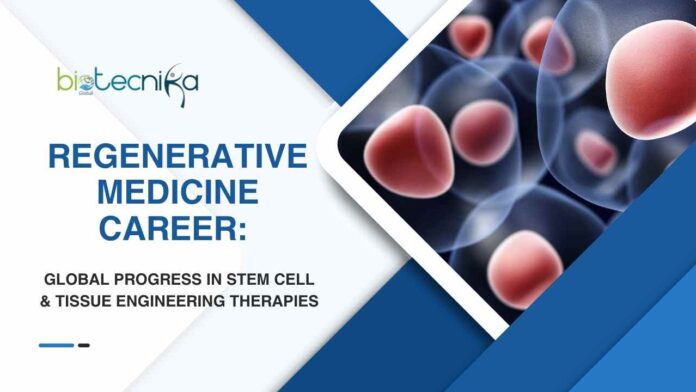Regenerative Medicine Career: Global Progress in Stem Cell and Tissue Engineering Therapies
As we are advancing towards the future of science, the regenerative medicine career is also being shaped by the enormous amount of research taking place in stem cell science, biofabrication, and clinical translation.
With significant advancements in technology, science is now very much capable of providing us with the powers that will not only help us accelerate the therapeutic approach to multiple conditions but also help to enable the repair and regeneration of damaged tissues and organs using stem cell therapies and tissue engineering. We can now accelerate the development of therapies and provide more effective treatments for different conditions. There are several laboratories, hospitals, and biotech companies that are developing therapies that are highly beneficial for patients.
In this article, we will help you understand the progress which has been made in the past years and about the advancements in stem cell technology and how it can benefit the mankind. We will also learn how the regenerative medicine career is so much more than a static path, it’s evolving and groundbreaking science, global collaboration, and it’s urgency to address complex health challenges. Like the field itself, this roadmap is an evolving journey shaped by ambition and teamwork, offering incredible opportunities in shaping the future of healthcare.
Stem Cell Frontiers Reshaping Therapies
There was a recent development in advanced biology is the discovery of induced pluripotent stem cells, also known as iPSCs. They are redefining the roadmap for regenerative medicine by making patient-specific treatments possible.
Researchers and medical professionals are now able to focus on a variety of medical conditions thanks to the development of iPSCs, and scientists can now focus on research and treatments for many of them. Clinical trials are lowering the risks of immune rejection by focusing on autoimmune diseases, heart failure, and vision loss.
Perinatal stem cells are another kind of stem cell that is being used and researched extensively. These perinatal stem cells are highly known for their versatility and minimal ethical controversy because they are derived from the placenta, amniotic fluid, and umbilical cord.
Engineering Functional Tissues
Scientists have built frameworks (scaffolds) using biomaterials or 3D printing to guide new tissue growth. This domain encompasses printing skin, cartilage, or even mini-organs, such as liver models, for testing the efficacy of medicines. 3D bioprinting and scaffolds are advanced techniques for developing soft tissue replacements. And this substantially offers precise control over the shape and porosity. Nanofiber scaffolds mimics the natural tissue structure in order to enhance overall cell growth.
The primary aim of these functional tissues is to develop those organoid structures that will help patients. Some examples of where these tissues can be used are: In skin grafts for burn victims, can be used for Cartilage Repair for joint injuries, and via organoids(which are tiny, organ-like structures) for drug testing and disease modeling. These practical applications show that the regenerative medicine career is advancing from lab studies into addressing real life medical problems.
Vascularized organoids are miniature, functional organs with blood vessel networks. There are many advantages of these organs, and one of the main advantages of using these vascularized organoids for research purposes is the better understanding of the effects of drugs during drug development processes. Also, testing drugs on these organoids can give us results that are very close or highly similar to what happens in the body, since they are known to closely mimic our actual body tissues.
Biohybrid structures represent another technological advancement that combines living cells with biodegradable materials to create heart patches, engineered arteries, and nerve conduits that integrate seamlessly with the patient’s tissue.
Translating Science to the Clinic
There are several early-stage trials that researchers are extensively studying. Most of the research is focused on examining stem cell injections for Type 1 diabetes, retinal disorders, and spinal cord injuries. In a few of the cases, some patients have already shown functional improvements.
Regulatory acceleration: To speed up the development of safe therapies along the regenerative medicine career without sacrificing patient safety, agencies in the USA, Europe, and Japan are implementing adaptive approval models.
A few of the major manufacturing hubs are listed here. They ensure preparedness for commercial launch, and facilities devoted to Good Manufacturing Practice (GMP) production are increasing the supply of cells and tissues.
Global Hotspots Driving Innovation
- Japan: It is considered one of the major global hotspots in the regenerative medicine career. This country is known for its initiating role in iPSC-based therapies, including treatments for muscular degeneration and Parkinson’s disease.
- United States: Here, Wake Forest Institute for Regenerative Medicine and Humacyte is leading the tissue engineering sector, from lab-grown arteries to bioengineered bladders.
- Europe: The University of Edinburgh’s Centre for Regenerative Medicine of this country integrates lab discoveries with industry partnerships for large-scale deployment.
- Australia: ARMI advancing therapies for neurotrauma, heart failure, and diabetes through strategic public–private alliances.
Integration of AI and Advanced Analytics
Integrating AI into research will boost the prediction processes and also help in optimizing the results in less time. AI algorithms can be used to determine the best culture conditions for particular therapeutic results, increasing yield and resulting in decreasing the need for trial-and-error methods.
During the production process, automated imaging and machine learning systems evaluate tissue integrity immediately as a part of quality assurance.
A promising development in treatment precision for personalized therapy is also designed, which uses AI-driven modeling and data to match patient profiles with specific cell and tissue types.
Opportunities for Careers Along the Roadmap
- Innovation in research: Working in this subject, which involves creating new stem cell lines, will be among the most fascinating. In both university and commercial facilities, researchers are also investigating a variety of career options in disease models and biofabrication techniques.
- There are multiple clinical applications that could be considered for the regenerative medicine roadmap. This could be one of the most rewarding career paths for candidates interested in clinical research. The primary job role includes coordinating with patient trials, bridging the gap between laboratory results and bedside treatments.
- One can also consider the manufacturing and scale-up sectors for their career advancements. Here, specialization in GMP operations helps to ensure quality and consistency in therapeutic products.
- Regulatory and ethics leadership: Responsible for composing global standards, navigating diverse legal frameworks, and safeguarding patient rights.
- Entrepreneurship and commercialization: Can start by launching biotech ventures in this impactful domain, creating platforms for novel therapies.
The regenerative medicine career is progressing from concept to clinic faster than any previous biomedical revolution. As regenerative strategies are advancing from iPSC-derived tissues to lab-grown vessels, the journey that lies ahead of us will demand coordinated global action. And the path will become much easier if we integrate with AI technologies. This will not only help us build a strong foundation but also involve strengthening the manufacturing networks. The whole purpose of these regenerative strategies is nothing but to keep the patient’s needs as the top priority and to provide with a successful treatment procedure.
So, professionals planning on entering this domain, the coming decade promises unmatched career opportunities in the sector of innovation, impact, and shaping the future of healthcare.






